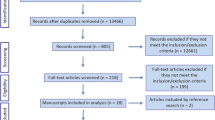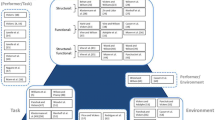Abstract
It has recently been reported that the spatial orientation of two moving limbs has a determining influence on the relative accuracy and stability of coordination patterns. The purpose of the present experiments was to test perceptual and neuromuscular explanations of these spatial orientation effects. Experiment 1 was an initial test of the hypotheses and an extension of a previous study [Lee et al. (2002) Exp Brain Res 146:205–212] that required participants to coordinate inphase and antiphase movement patterns in four spatial orientations: two symmetric orientations (90° and 180° separation between the limbs) and two asymmetric orientations (90° and 135° separation between the limbs). Results of Experiment 1 suggest that the symmetry of movement may be a key factor influencing spatial orientation effects observed during interlimb coordination. In Experiment 2, participants again performed inphase and antiphase movement patterns in symmetric and asymmetric spatial orientations. However, one-half of the participants in Experiment 2 were provided with mechanical constraints during the performance of the desired coordination patterns. The mechanical constraints provided postural support but did not influence the visual experience. Results showed that the addition of the postural support improved performance. These findings suggest that neuromuscular, and perhaps biomechanical, constraints contribute more to the influence of spatial orientation than visual–perceptual constraints.





Similar content being viewed by others
Notes
This assumption is based on the following logic: Lee et al. found inphase dominance at parallel-180°, but antiphase dominance at orthogonal-90°. These findings parallel the “matched” and “unmatched” conditions of the study by Carson et al. 2000), respectively. Given that Fuchs and Jirsa (2000) associated the “matched” and “unmatched” conditions with σ=0 and 1, respectively, we associated parallel-180° with σ=0 and orthogonal-90° with σ=1.
The incorporation of an “imperfection parameter” that acts as a general symmetry breaking term, as suggested by Amazeen et al. (1998), may be a worthwhile consideration. Within this imperfection term, it seems likely that a postural stability factor may act as a multiplicand which is dependent on the maximal amount of rotational and translational displacement of a body’s vertical axis for a given spatial orientation. Future consideration will be given to this issue.
It must be acknowledged here that we cannot say with certainty how the muscular synergies changed under the different postural manipulations. For example, we did not record muscle activity (EMG) from the trunk muscles to quantify differences in activation patterns across the spatial orientations nor did we probe the excitability of the specific motor pathways (e.g., Baldissera et al.1998; 2002; Carson et al. 1999; Carson and Riek 2002). Although such information would be extremely useful and will be sought in the future, we feel that it is not necessary for our interpretation of the results. Given that the postural support could only affect the size of the perturbations to the trunk, and subsequently the amount of work the trunk muscles would need to do to maintain an upright posture, the effort to maintain posture and work done by the trunk muscles was undoubtedly decreased. This could only point to a neuromuscular explanation.
References
Amazeen PG, Amazeen EL, Turvey MT (1998) Breaking the reflectional symmetry of interlimb coordination dynamics. J Motor Behav 30:199–216
Baldissera F, Cavallari P, Leocani (1998) Cyclic modulation of the H-reflex in a wrist flexor during rhythmic flexion–extension movements of the ipsilateral foot. Exp Brain Res 118:427–430
Baldissera F, Borroni P, Cavallari P, Cerri G (2002) Excitability changes in human corticospinal projections to forearm muscles during voluntary movement of ipsilateral foot. J Physiol 539:903–911
Carson RG (to be published) Governing coordination: Why do muscles matter? In: Jisra VK, Kelso JAS (eds) Coordination dynamics: issues and trends. Springer, Berlin Heidelberg New York
Carson RG, Riek S (2000) Musculo-skeletal constraints on corticospinal input to upper limb motoneurones during coordinated movements. Hum Mov Sci 19:451–474
Carson RG, Riek S, Bawa P (1999) Electromyographic activity, H-reflex modulation and corticospinal input to forearm motoneurones during active and passive rhythmic movements. Hum Mov Sci 18:307–343
Carson RG, Riek S, Smethurst CJ, Parraga JF, Byblow WD (2000) Neuromuscular-skeletal constraints upon the dynamics of unimanual and bimanual coordination. Exp Brain Res 131:196–214
Fuchs A, Jirsa VK (2000) The HKB model revisited: how varying the degree of symmetry controls dynamics. Hum Mov Sci 19:425–449
Haken H, Kelso JAS, Bunz H (1985) A theoretical model of phase transitions in human hand movements. Biol Cybern 51:347–356
Kelso JAS (1984) Phase transitions and critical behavior in human bimanual coordination. Am J Physiol 246: R1000–R1004
Kelso JAS (1995) Dynamic patterns: the self-organization of brain and behavior. MIT Press, Cambridge, MA
Lee TD, Blandin Y, Proteau L (1996) Effects of task instructions and oscillation frequency on bimanual coordination. Psychol Res 59:100–106
Lee TD, Almeida QJ, Chua R (2002) Spatial constraints in bimanual coordination: influences of effector orientation. Exp Brain Res 146:205–212
Lewis GN, Byblow WD (2002) Modulations in corticomotor excitability during passive upper-limb movement: is there a cortical influence? Brain Res 943:263–275
Mechsner F, Kerzel D, Knoblich G, Prinz W (2001) Perceptual basis of bimanual coordination. Nature 414:69–73
Schmidt RA, Lee TD (1999) Motor control and learning: a behavioral emphasis. Human Kinetics, Champaign, IL
Scholz JP, Kelso JAS (1989) A quantitative approach to understanding the formation and change of coordinated movement patterns. J Motor Behav 21:122–144
Serrien DJ, Bogaerts H, Suy E, Swinnen SP (1999) The identification of coordination constraints across planes of motion. Exp Brain Res 128:250–255
Swinnen SP, Wenderoth N (2004) Two hands, one brain: cognitive neuroscience of bimanual skill. Trends Cogn Sci 8:18–25
Swinnen SP, Jardin K, Meulenbroek R, Dounskaia N, Hofkens-van den Brandt M (1997) Egocentric and allocentric constraints in the expression of patterns of interlimb coordination. J Cogn Neurosci 9:348–377
Swinnen SP, Jardin K, Verschueren S, Meulenbroek R, Franz L, Dounskaia N, Walter CB (1998) Exploring interlimb constraints during bimanual graphic performance: effects of muscle grouping and direction. Behav Brain Res 90:79–87
Swinnen SP, Dounskaia N, Duysens J (2002) Patterns of bimanual interference reveal movement encoding within a radial egocentric reference frame. J Cogn Neurosci 14:463–471
Turvey MT (1990) Coordination. Am Psychol 45:938–953
Acknowledgements
This research was funded by the Natural Sciences and Engineering Research Council of Canada.
Author information
Authors and Affiliations
Corresponding author
Additional information
Each of the co-authors contributed equally to the development and completion of this project.
Rights and permissions
About this article
Cite this article
Welsh, T.N., Almeida, Q.J. & Lee, T.D. The effect of postural stability and spatial orientation of the upper limbs on interlimb coordination. Exp Brain Res 161, 265–275 (2005). https://doi.org/10.1007/s00221-004-2062-3
Received:
Accepted:
Published:
Issue Date:
DOI: https://doi.org/10.1007/s00221-004-2062-3




